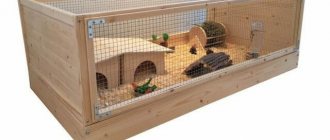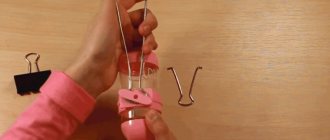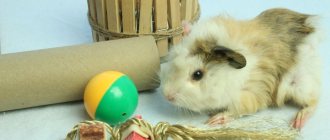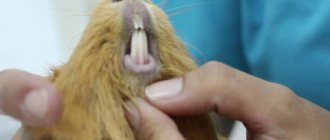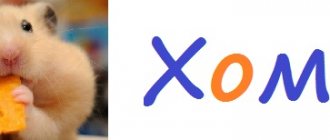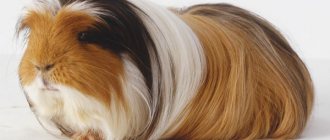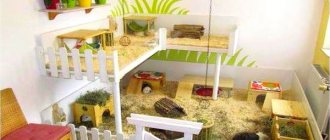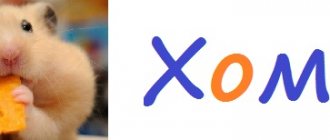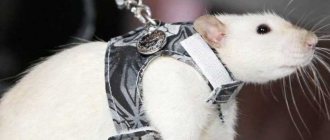Why does a pig need a lot of personal space?
Your pet at times wants to retreat and relax alone, away from neighbors, annoying noises and constant stares. A guinea pig's house will allow her to relax, eat, and also hide from frightening sounds. The gift will be a joy for your pet; he will become interested in his new home and will stay there most of the time while the owner is not around.
If you have several pets, it is advisable to make a separate home for each rodent. This way they will rest, recharge with energy and be ready to frolic again. It is not advisable to disturb a pig that is inside its home. You may upset or even anger the rodent. As soon as the pig finishes resting, it will come out on its own.
Drinking fountain
Such a device can serve not only to quench the thirst of animals, but also become an original accent in the home interior. The design consists of a water bowl, a filter, a diffuser and a drinking bowl located at the top. Additionally, it is equipped with a decorative sprinkler, especially popular with native breeds (Maine Coons, Kuril Bobtails, Siberian cats).
Continuous circulation of liquid is ensured by a mini-pump powered by a USB cable. More advanced models may contain backlighting and an indication of the level of remaining water in the tank.
Cost – 2400 rub.
Qualities of a good house
In order for the pig to feel good in its home, you should take care of important factors:
- It is important to maintain the temperature at 17–20 degrees.
- You should regularly ventilate the cage, but avoid drafts. They can tell a bad story about the condition of the animal.
- Your pet's home needs good lighting, given the fact that direct sunlight is harmful to the rodent.
When the necessary conditions have been created in the cage, you need to think about the quality of the house itself. It must have the following properties:
- The house should be spacious and roomy so that the animal can easily be placed in a vertical and horizontal position.
- The entrance must correspond to the size of the animal so that it can squeeze through without difficulty.
- It is important to ensure the safety of your pet’s home. The animal may try to chew it, and if it is coated with paint or varnish, it will negatively affect health and cause poisoning. And you also need to avoid sharp protruding parts: nails, screws. It is desirable that all corners of the housing be rounded.
- There should be free air circulation in your pet’s home, so you need to make windows in the walls (preferably round). However, narrow crevices should be avoided, otherwise the animal’s paw may get stuck.
Moving toys
From the name it is clear that these objects can be moved, pushed, rotated, moved around the cage and beyond.
House keys
It is worth noting that the presence of toys in a chinchilla’s cage is mandatory. In their absence, the animal will have nowhere to expend energy, which can lead to many bad habits. For example, some animals chew out their fur out of boredom.
walking ball
A convenient device that allows the animal to walk around the apartment without the risk of being lost or crushed. It’s better to buy a wheel than to walk around your living space while walking; a lot of tragedies happen, they are quick and you can’t always keep track of them. Walking balls are a fairly new invention. They are available in different sizes for different types of rodents.
The ball is closed with a lid, the animal rolls around the whole house, moving its paws, and the translucent walls of the ball allow the animal to see everything that is happening around it. When purchasing and using a walking ball, ensure its strength and be extremely careful when closing the lid!
Flaws:
- ventilation holes usually cannot provide sufficient circulation of air inside, which is why the animal begins to suffocate after a while;
- Frequent cases of overheating of animals inside such balls are known.
Hanging toys
Initially, such devices were offered for birds, but chinchillas also happily accept these trinkets
Particular attention is drawn to pendants that shake, wobble, rattle and ring - rodents like to push them and swing them from side to side. Sometimes they even try to taste the thing
Toy with a bell
The only disadvantage of rattles is that they create excessive noise, since chinchillas usually like to play in the dark. To prevent the ringing from annoying you, it is better to take the toy out of the cage before going to bed, giving both yourself and the animal a rest.
Rotating wheel
Chinchillas are simply crazy about wheels in a cage - they can run around inside for hours without leaving the product even while sleeping.
There are 4 main types:
- wooden;
- plastic;
- metal;
- aluminum.
Advantages of making a wheel yourself
There are two main reasons why you should make your own wheel for a chinchilla:
- Opportunity to save. A DIY chinchilla wheel is an excellent opportunity to protect yourself from wasting money on a unit that is sold at high prices in pet stores.
- Quality assurance. You will definitely be sure that all the parts and elements of the toy for your pet were made from high-quality materials.
In fact, making your own wheel is not difficult. This way you can express your love and care to the little furry animal.
Housing materials
You can make a home from almost any material. If you decide to make a house for a guinea pig, then you will need:
- plywood;
- cardboard, including boxes;
- iron grille covered with a fabric base;
- ceramic pots;
- parts of children's construction sets;
- plastic containers.
A wooden house for a guinea pig is distinguished among all others by its strength and durability. No material can compare with wood in these aspects, however, what to make a house from is a personal choice for everyone according to the preferences and skills of the owner.
Simple wire cutters
The most primitive device is very similar to ordinary scissors. Only one of its cutting surfaces is equipped with a small notch with a sharp edge. Using such a device is easy, provided you have some skill and experience. For young dogs, nail trimming is always stressful. They do not want to sit quietly, they strive to tear the paw out of the owner’s hands and in every possible way complicate the process. So Litbro.ru will not recommend such a gadget to novice dog breeders. The risk of causing serious physical injury to your pet is too great. Well, for experienced owners who have used similar tools more than once, nothing better can be desired. Cheap and very effective.
Cost – 35 – 72 rubles.
More advanced versions of hand cutters offer expanded functionality.
Although their main part, in the old fashioned way, is based on two cutting surfaces. Service additions imply only human convenience. Models with rounded ends, a container for cut claws and lighting have proven themselves very well. The fact is that some dogs have the habit of looking for clipped ends on the floor and eating them. Sharp, bent cuttings can damage the stomach wall and cause bleeding. A small “waste collection” effectively solves this problem.
Price – 636 rub.
Another gadget from the line of simple nippers has comfortable ergonomic handles that allow you to securely hold the tool while trimming nails.
This is important when the animal gets nervous and breaks out.
We pay attention to one more detail - the expansion spring. It fixes the cutting surfaces in the open state, which makes the operation somewhat easier.
Otherwise, the functions of the device duplicate all the features of its predecessors. To properly shorten claws, you must have the skill and achieve unquestioning obedience from your dog or cat.
Cost – 229.93 rubles.
Made of wood
Wood is often used as a base. A wooden house for a guinea pig will last a long time and will not harm the animal due to the natural nature of the material. A rodent can use such housing to grind its teeth, so it is not advisable to choose oak, plum or cherry wood because of the harmful substances in it for the pet. Still, the tree has a certain series of disadvantages:
- If the material is not treated, pests will settle in it;
- the weight of the house will be quite large, which will make some actions difficult;
- the color palette when choosing is limited;
- if you do not remove the sharp parts: burrs and splinters, the animal may be injured;
- It is not easy to clean such material, which causes bacteria and an unpleasant odor to accumulate.
To make a wooden house for a guinea pig, treated boards or plywood are used. The size of the house and its entrances should be calculated depending on the volume of the pig. It is important that she does not get stuck in the passage and can move around calmly. Such a house should be intensively processed: hammer in all the nails, leaving no heads or sharp ends, and also sand off all burrs on the walls so that the pig does not get hurt.
Construction stages:
- You should prepare all the necessary parts of the structure and make drawings of the future house, not forgetting the entrance and windows. It’s better not to make the bottom, this will make cleaning up after the animal much easier.
- Transfer the dimensions from the drawings onto plywood and cut out the components of the home. The optimal volume for a home will be 45X35X25 cm.
- Process the resulting parts carefully, leaving no burrs.
- Use nails to connect the structure. It is necessary to drive the nails in so that the head and sharp tip do not remain, otherwise the animal will be injured.
It is important to pursue not the pleasant appearance of the design, but its functionality and convenience.
Manufacturing procedure
To prepare for work, a diagram is made taking into account all specific dimensions. You can take any drawing of a rack or shelf as a sample. Substitute your dimensions, making sure to check whether the rack will fit in the space allocated for it.
Rack drawing
Don't make the shelves too deep, as this will make cleaning difficult. The distance between floors should be sufficient so that the pigs can stand on their hind legs if necessary. Once the drawing is ready, start manufacturing:
The finished diagram is transferred to the material using a marker with a ruler. To cut parts from wood, use a jigsaw or hacksaw. If necessary, a frame is assembled from wooden blocks. The base and ceiling of the second floor are treated with silicone sealant or other waterproof impregnations. Another option is to purchase plastic trays for the filler, but it is not always possible to find the right size. The side walls are attached to the base using tie screws or self-tapping screws. Large ventilation windows should be installed at the first floor level. The side windows are covered with a mesh, which is secured with screws. The ceiling of the second floor is installed, a hatch hole for the ramp is made in advance. The top floor can be left open for better ventilation; the absence of a ceiling will also make cleaning easier
It is important that the walls are higher than 30 cm, then the pig will not be able to jump out and hurt itself. If you decide to close off the second floor, you can use drop-down plexiglass doors. It is recommended to attach all doors to furniture hinges. Inside the rack you must place several shelters for resting and sleeping, preferably one for each animal
The pig will also like shelves and elevations. Don't forget about toys - otherwise the rodent will take on the parts of its home. In order to make it convenient for the animals to climb to the second floor, it is better to install not a wire staircase, but a ramp - a flat, wide board with glued slats.
Shelf with additional lighting
The rack itself must be placed at a sufficient height, at least 15-30 cm, otherwise the animals will be exposed to drafts.
The solution may be to install the product on a bedside table, which can be conveniently used for storing litter, hay and other accessories for caring for pigs. If there is insufficient lighting at the location of the rack, it is recommended to provide additional lighting. Attach hanging fluorescent lamps on each floor.
From the box
This is the easiest option for housing your pet. Any cardboard box, for example a shoe box, is suitable for making. It is important that it fits the animal.
All that is needed for construction is to make entrances and windows. For decoration, you can add some decorative details, here everyone has a free flight of imagination.
Such a house for a guinea pig is suitable for owners who do not have the skills or time for serious construction.
Basic requirements when creating a cell
A guinea pig needs a spacious home in which it can move freely and have fun. In addition, the parameters of the cage must be such that the animal can be safely taken out or put in.
At the same time, the enclosure must be durable, since a domestic rodent can chew through not only cardboard, but also wood. The most advantageous option would be a housing with a plastic bottom and an easily removable upper part.
It is very important that the rodent cage meets the following requirements:
Smooth, smooth ceiling, floor and walls. They must also not contain cracks or burrs. Ease of care. Cleaning the home, removing dirt, disinfecting and feeding should take place in maximum accessibility and comfort. Access to light and air. There should be constant daylight and fresh air flow. To keep several animals you need to have several cages
This condition is important to prevent disease outbreaks. In this case, the blocks will be difficult to disinfect, unlike a separate cell.
From cardboard
All you need is cardboard. To make the walls, measure the cage, calculate the volume of the house you need and transfer the information to the drawings. Cut out all the pieces from cardboard. Then connect the walls.
For the roof, separately make a suitable piece of cardboard and glue it to the structure. Then it is advised to ventilate the house to get rid of the smell of glue.
Advice from experienced professionals
So, making an economy apartment for your pet on your own doesn’t seem difficult. But owners and breeders with decent experience in keeping rodents are advised to listen to the recommendations for home improvement:
- It is advisable to use a plastic tray at the bottom, which the animal cannot chew through. Alternatively, using a base pattern, the bottom and sides can be made from polycarbonate, connecting the sides with construction angles. Or make it from 8 mm thick plywood, gluing the ends together with non-toxic glue. By spending a little more money, the owner will make the cleaning process easier.
- The grid cells should not be larger than 2.5 mm. This is due to the safety of the animal.
- All internal surfaces of the home should be free of cracks.
- For comfortable adaptation of a new friend, it is advisable to cover 2-3 side walls with opaque material (cardboard, thick fabric) for the first weeks of keeping. The animals are shy and sudden movements can frighten them. As you get used to it, the fences are removed to allow natural sunlight to penetrate.
- For pets who practice walking around the apartment, during the installation process it is necessary to consider a door for free entry and exit.
- For multi-level rodent apartments, wooden ups and downs along the edges should be covered with thin planks, marking the edges. If a pig falls, even from a small height, it can cause injury.
Having arranged the cage, you need to take care of the contents. The filler for the bottom and bedding should be the one your pet is used to.
A spacious, comfortable enclosure for a family of rodents with two levels, equipped with a sleeping area and a corner for hay. The feeder and drinking bowl are cleverly located in different places, pushing the animal to overcome obstacles.
Three-room apartment for a rodent. The area for sleep, rest and active games is demarcated. The cage is designed for a large family.
Residential complex for an energetic pet. The ascent with a tunnel, a large hay barn, toys and manholes are conducive to achievements and conquering peaks.
Like any living creature, a guinea pig deserves a comfortable home filled with a variety of accessories. By making a pet cage with your own hands, the owner will express love and care.
Made of plastic
It is better to make such a dwelling from hard plastic. The choice for construction is extensive - you can use a plastic box or container. The beauty of this material is the large selection of colors, and this will help make an interesting house for a guinea pig. A dwelling made of colored plastic will delight the pig and its owners due to its pleasant appearance.
In order not to constantly think about cleaning the animal, it is better to get rid of the lower part, leaving the floor empty. It is important to monitor the animal so that it does not chew the plastic. Such an ingredient in his diet can ruin his digestion, not to mention its toxicity.
HOME AMUSEMENT PARK
If the space in your house allows you, then you can make an entire amusement park for your pets.
Naturally, this requires a territory much larger than a cage, so you will have to organize some kind of enclosure. The fencing materials can be of your choice (maybe even simple cardboard, but pets can chew it off), but the most important thing to remember is that they need to be safe first and foremost, so avoid anything sharp or prickly. Guinea pigs love hay very much, so it can become the main consumable.
They can line the bottom of the enclosure. After which you need to make a house for the pigs. It can be purchased or made with your own hands from a cardboard box or wood
Guinea pigs love hay, so it can become the main consumable. They can line the bottom of the enclosure. After which you need to make a house for the pigs. It can be purchased or made with your own hands from a cardboard box or wood.
Read about how to distinguish a boy from a girl parrot, the distinctive features of different types of parrots.
What is the life expectancy of guinea pigs if you feed and care for them correctly - https://tvoipitomec.com/gryizunyi/skolko-zhivut-morskie-svinki-v-domashnih-usloviyah.html
A pet needs to hide somewhere if it gets scared of something. You can put several cubes in the enclosure that will be connected by bridges; you can also make them yourself. The shape can be chosen by you, it depends only on your imagination. Organizing several levels in an enclosure would also be a very interesting idea.
These levels can again be connected by bridges or tunnels. They can also be made from twigs, hay, cardboard, or, as a last resort, bought at a pet store. You can put several balls and small soft toys in the enclosure, and install a mirror.
Guinea pigs, by nature, love to burrow in the dirt or sand. So give them this opportunity! Find a place where you can pour enough sand or soil, and let them dig to their heart's content! You can also hide a few seeds or nuts there to arouse even more interest in your pet.
You should, of course, take care of water for your pet. During its stay in the enclosure, the pig will not get too hungry, but it will want to drink, because it will constantly run around.
Video: choosing a cage for a pet
https://youtube.com/watch?v=KTXQWy8M9jA
Pets have their own opinions too
You shouldn’t expect your pets to accept any idea you have with great joy. Not all toys will be to their liking, regardless of whether they were made with their own hands or bought for a lot of money.
Each pig, like a person, has its own characteristics and whims. Try to remove for a while what does not cause her much interest at the moment, and after a while put it back. Maybe the animal was simply not in the mood.
If you still don’t show interest, you can try giving the animal a stimulus—a treat. You can put some fresh fruit at the end of a tunnel or staircase, and make a path of seeds in the maze. At least in this way, they need to be attracted to physical activity so that they do not become obese.
Decorative guinea pigs are wonderful animals, they will not cause you much trouble. But if you decide to get such an animal, be sure to remember that they are very active.
It is important for them to engage in physical activity and somehow spend time while you are not around, so try to organize leisure time for your pet as much as possible
Paper bag
A very unusual and simple option for housing a pet. You just need a package that should be placed in the cage and the pig will immediately take a liking to it. Rodents will be happy to tinker with it, making rustling sounds. To support the walls of such a house, add hay. It should be remembered that housing will quickly deteriorate. This is due to the fact that the paper gets wet very quickly and the house needs to be thrown away. The bag can also be used as bedding by tearing it into small pieces.
Why do rats use shelter?
Tame domestic rats may use the cage house quite rarely, but this does not mean that they do not need it. All pets need shelter at certain times.
Stress
Even very tame rats are frightened by unfamiliar people, changes in their usual routine, and loud noises. Without a place to hide, your pet will develop stress, which can lead to aggression.
Bad mood, malaise
If an animal feels unwell, it feels an instinctive need to hide, to make sure that it is reliably protected.
How to arrange your home
It is important to place litter, a drinking bowl and a feeder in the animal’s house. This way, your pet will feel good and be able to relax.
If pigs are worried and refuse food, then there is no need to change it. A standard diet should be maintained. You can add a few of your animal's favorite ingredients to help him relax.
Toys, if any, need to be moved into the guinea pig's house. Rodents love to chew on something, so wood or paper will do, but the main thing is to avoid small parts.
Drinking fountain
Such a device can serve not only to quench the thirst of animals, but also become an original accent in the home interior. The design consists of a water bowl, a filter, a diffuser and a drinking bowl located at the top. Additionally, it is equipped with a decorative sprinkler, especially popular with native breeds (Maine Coons, Kuril Bobtails, Siberian cats).
Continuous circulation of liquid is ensured by a mini-pump powered by a USB cable. More advanced models may contain backlighting and an indication of the level of remaining water in the tank.
Cost – 2400 rub.
The advantages of a homemade dwelling are as follows:
- ease of cleaning; — the ability to separate the feeding area; — resettlement of conflicting or different-sex individuals; — the opportunity to diversify or complement the interior of your home; - comparatively cheap compared to a cage from a pet store; — guinea pigs will simply be more interested in exploring their new space, and as a result they will feel much more comfortable and happier; - an opportunity to feel like an architect - after all, designing a house for your beloved pet is exciting, fun and interesting!
It is best to install the rack against a wall or in a corner. Its size depends on your desire and the area you are willing to devote to it. The optimal size for a comfortable stay for guinea pigs: 1m x 1m. A multi-level house is suitable for several individuals or for raising a large family. If you wish, the levels can be made up to the ceiling! This way the rack will be more stable. But if the guinea pig is already elderly, it is advisable to do without multi-story buildings.
If you want to watch what a guinea pig is doing in the house, make one of the walls out of plexiglass
So, for work you will need the following materials:
- wooden boards - plexiglass - durable plastic
Tools:
- hand saw; - electric jigsaw; - ties, screws, nails; - hammer; - screwdriver; - pencil, marker; - glass cutter; - ruler; - construction glue.
Manufacturing stages:
1) In accordance with the drawing, we cut out walls and shelves from wood; made of plastic - the bottom of the future enclosure; 2) We make little holes in the shelves so that the pig can climb to the second floor; 3) Using a glass cutter, cut out one of the walls; 4) We attach the wooden and glass walls to the bottom using self-tapping screws and metal ties; 5) From materials that were not used, we make ladders, transitions, partitions and firmly fix them inside the rack either using construction glue or using small screws and a screwdriver; make sure that additional parts of the enclosure do not wobble and have the opportunity to fall on defenseless pigs; Also, be careful that there are no screws, nails or other potentially dangerous parts sticking out anywhere that could injure the delicate skin of the guinea pig; 6) Next we place bowls, bedding, beds, drinking bowls; 7) Fill the bottom and shelves with sawdust and hay; We are moving a furry newcomer into a new home!
made of plastic - the bottom of the future enclosure; 2) We make little holes in the shelves so that the pig can climb to the second floor; 3) Using a glass cutter, cut out one of the walls; 4) We attach the wooden and glass walls to the bottom using self-tapping screws and metal ties; 5) From materials that were not used, we make ladders, transitions, partitions and firmly fix them inside the rack either using construction glue or using small screws and a screwdriver; make sure that additional parts of the enclosure do not wobble and have the opportunity to fall on defenseless pigs; Also, be careful that there are no screws, nails or other potentially dangerous parts sticking out anywhere that could injure the delicate skin of the guinea pig; 6) Next we place bowls, bedding, beds, drinking bowls; 7) Fill the bottom and shelves with sawdust and hay; We are moving a furry newcomer into a new home!
It is important to remember that wood absorbs odors and moisture over time. Chipboard is the most moisture-resistant material and is safe for animals. If the wooden parts of the enclosure require painting, you must choose non-toxic paint mixtures
Do you like to follow the life of a guinea pig in the house? Poll Options are limited because JavaScript is disabled in your browser.
You can make a house out of a closet
Cage shelving made from finished furniture
A cozy house for pigs can be made not only from purchased materials. Old unnecessary furniture, a cabinet or a display case are also suitable for this task.
SHOW RACK
You can purchase a ready-made multi-story display case. These are sold in the IKEA store. It is ideal to replace glass shelves with wooden ones. To prevent pigs from chewing through the wood, it must be painted. We reconstruct the showcase to choose from: either we leave separate spaces if the individuals are in conflict or they are of different sexes; or we connect them with ladders-transitions. They can be made of wood or plastic.
METAL RACK
The metal frame can be fused from several structures. Construction adhesive or cable ties are suitable for this. It is better to make the end wall from wood or plywood. The shelves should be attached upside down to look like pallets, and the doors should be made transparent. A plastic bottom is suitable for such racks so that the animals’ paws do not fall through the bars of the metal grate.
BOOKSHELF
If you have a small old wardrobe, it is ideal for converting into a guinea pig's home. The main thing is to make the distance between the shelves wider so that the pet can easily stand on its hind legs. The cabinet doors can be replaced with plexiglass - this makes it more convenient to observe the life activities of the piglets.
Good old homemade ladders can serve as transitions between tiers. If transitions are not required, then residents will live in their own personal rooms. Either linoleum or plastic is laid at the bottom of each room. It is also worth taking care of lighting: furry animals should not live in semi-darkness. To solve this problem, some cabinet walls are replaced with bars or plexiglass.
Step-by-step instruction
Before making the structure, you need to select the dimensions for the home. If there are several sea rodents, then you need to make a large dwelling.
If there are pregnant women or small pets inside the cage, then they need to be provided with additional protection along the edges of the home.
You need to choose dimensions with a rectangular cross-section. The dimensions of the lower base will depend on the size of the rodent's home.
The recommended height is 16 cm.
You need to draw the lower part of the future home on cardboard. To make the sides, you need to measure a distance of 16 cm on each side and connect them with lines. Corrugated cardboard can have 2 layers and air pockets between them. By cutting through the top layer, you can bend the corrugated cardboard 90 degrees. On its first layer you need to make a cut, then cut the sheet, assemble the box and cover it with tape. Then you need to fold the edges. To do this, bend the protruding edges of the sides to the opposite side and, using adhesive tape, glue them together.
The result should be a rectangular box without a top.
Now you need to assemble walls from metal gratings - they will go along the perimeter of the rodent’s home.
Panels need to be cut out of them. The height of the panel should be twice the height of the box itself. To prevent the individual from being injured, it is necessary to process the edges of the panels. Use cable ties to connect the panels. The ends of the cable ties should be trimmed. Each side must be assembled separately. The length of all sides must be appropriate.
Now you need to attach the cardboard box to the bars.
Using cable ties, you need to connect the edges of the sides together. You also need to tie the edges on the top, bottom and center parts. The resulting angle should be right. You cannot attach the sides tightly together, as this will make it impossible to connect the sides on the opposite side of the cage.

